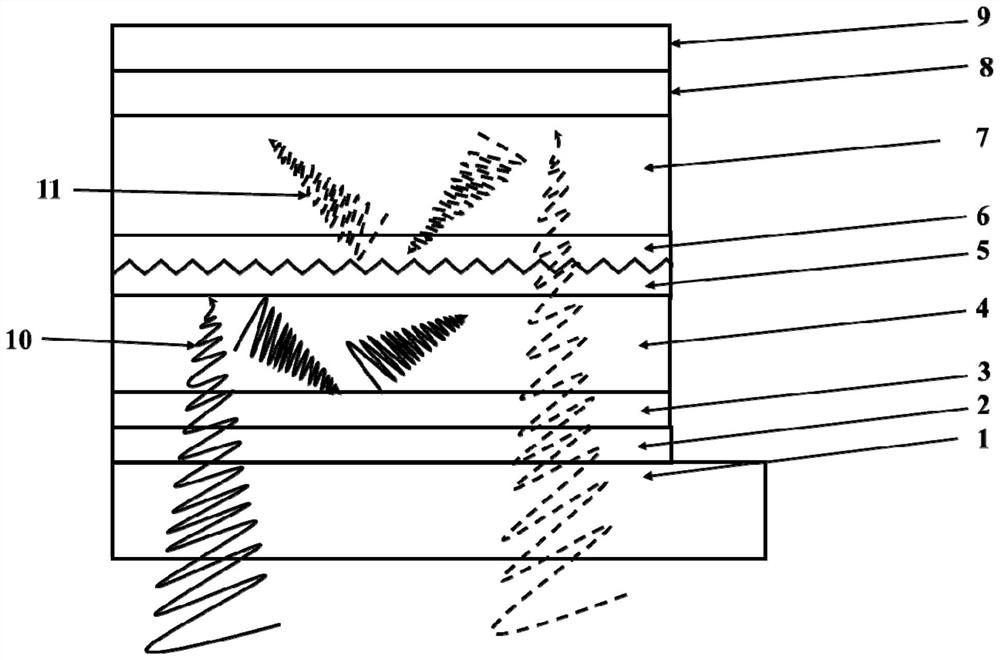Organic solar cell based on triangular prism grating imprinting and production method thereof
A technology of solar cells and triangular prisms, applied in photovoltaic power generation, circuits, electrical components, etc., can solve the problems of low photogenerated carrier transfer efficiency and lower device performance, and achieve the goal of ensuring absorption, improving device performance, and increasing short-circuit current Effect
- Summary
- Abstract
- Description
- Claims
- Application Information
AI Technical Summary
Problems solved by technology
Method used
Image
Examples
Embodiment 1
[0036] Embodiment 1 (control group):
[0037] 1. Clean the substrate composed of transparent substrate and transparent conductive cathode ITO with surface roughness less than 1nm, and dry it with nitrogen after cleaning;
[0038] 2. Spin-coat PEDOT:PSS (3000rpm, 60s, 40nm) on the surface of the transparent conductive cathode ITO to prepare the anode buffer layer, and perform thermal annealing on the formed film (150°C, 1h);
[0039] 3. Connect PBDB-T:PC 71 After the BM solution was dripped on the center of the PEDOT:PSS anode buffer layer, the active layer 4 of the top cell was prepared by a spin coating process (2000rpm, 60s, 80nm), and annealed (100°C, 30min);
[0040] 4. After the ZnO NPs dispersion liquid is drop-coated on the center of the active layer 4 of the top cell, a ZnONPs cathode buffer layer (3000rpm, 40s, 50nm) is prepared by a spin coating process, and annealed;
[0041] 5. After dropping the PEDOT:PSS precursor solution on the ZnO NPs cathode buffer layer, the...
Embodiment 2
[0047] 1. Clean the substrate composed of transparent substrate and transparent conductive cathode ITO with surface roughness less than 1nm, and dry it with nitrogen after cleaning;
[0048] 2. Spin-coat PEDOT:PSS (3000rpm, 60s, 40nm) on the surface of the transparent conductive cathode ITO to prepare the anode buffer layer, and perform thermal annealing on the formed film (150°C, 1h);
[0049] 3. Connect PBDB-T:PC 71 After the BM solution was dripped on the center of the PEDOT:PSS anode buffer layer, the active layer 4 of the top cell was prepared by a spin coating process (2000rpm, 60s, 80nm), and annealed (100°C, 30min);
[0050] 4. After the ZnO NPs dispersion liquid is drop-coated on the center of the active layer 4 of the top cell, a ZnONPs cathode buffer layer (3000rpm, 40s, 50nm) is prepared by a spin coating process, and annealed;
[0051] 5. Use a triangular prism nanoimprint plate (width: 0.3um, height: 30nm) to imprint the ZnO NPs cathode buffer layer to prepare a...
Embodiment 3
[0058] 1. Clean the substrate composed of transparent substrate and transparent conductive cathode ITO with surface roughness less than 1nm, and dry it with nitrogen after cleaning;
[0059] 2. Spin-coat PEDOT:PSS (3000rpm, 60s, 40nm) on the surface of the transparent conductive cathode ITO to prepare the anode buffer layer, and perform thermal annealing on the formed film (150°C, 1h);
[0060] 3. Connect PBDB-T:PC 71 After the BM solution was dripped on the center of the PEDOT:PSS anode buffer layer, the active layer 4 of the top cell was prepared by a spin coating process (2000rpm, 60s, 80nm), and annealed (100°C, 30min);
[0061] 4. After the ZnO NPs dispersion liquid is drop-coated on the center of the active layer 4 of the top cell, a ZnONPs cathode buffer layer (3000rpm, 40s, 50nm) is prepared by a spin coating process, and annealed;
[0062] 5. Use a triangular prism nanoimprint plate (width: 1um, height: 50nm) to imprint the ZnO NPs cathode buffer layer to prepare a Z...
PUM
| Property | Measurement | Unit |
|---|---|---|
| Concentration | aaaaa | aaaaa |
| Thickness | aaaaa | aaaaa |
| Thickness | aaaaa | aaaaa |
Abstract
Description
Claims
Application Information
 Login to View More
Login to View More - R&D
- Intellectual Property
- Life Sciences
- Materials
- Tech Scout
- Unparalleled Data Quality
- Higher Quality Content
- 60% Fewer Hallucinations
Browse by: Latest US Patents, China's latest patents, Technical Efficacy Thesaurus, Application Domain, Technology Topic, Popular Technical Reports.
© 2025 PatSnap. All rights reserved.Legal|Privacy policy|Modern Slavery Act Transparency Statement|Sitemap|About US| Contact US: help@patsnap.com

